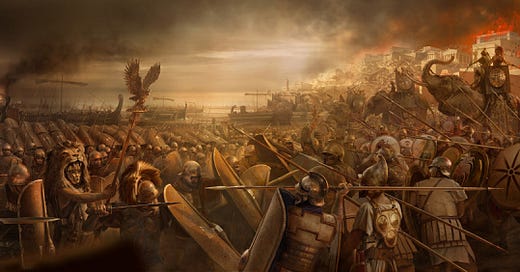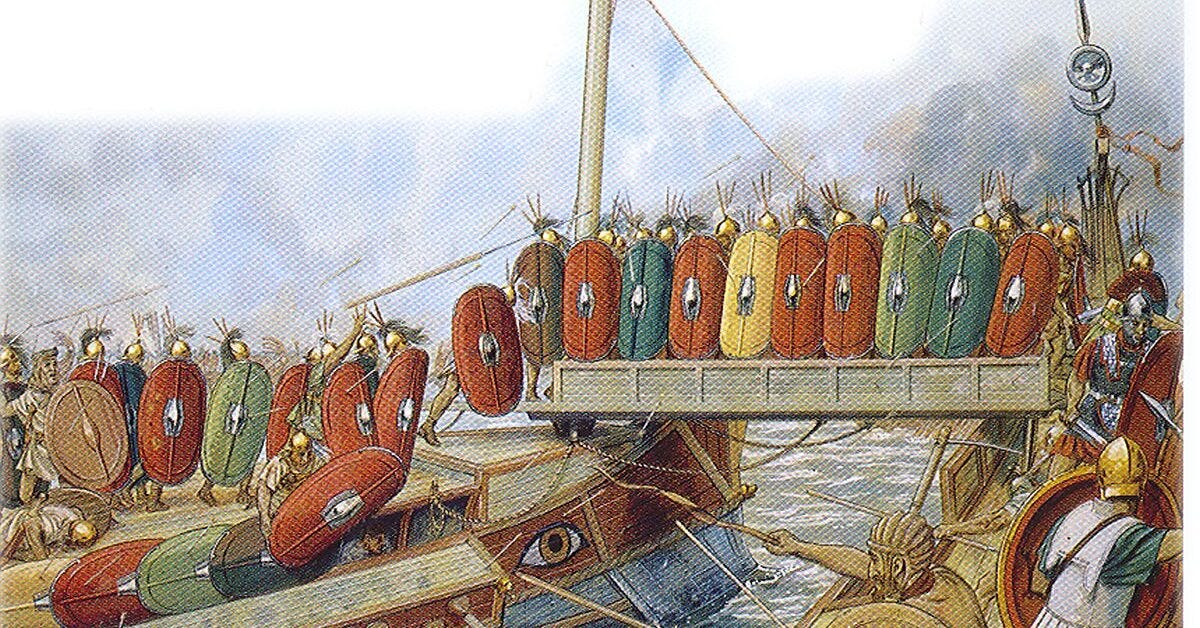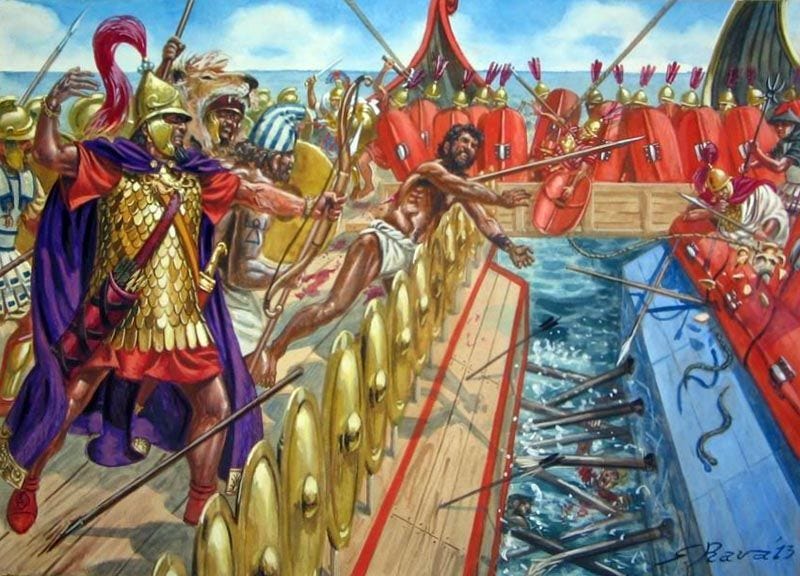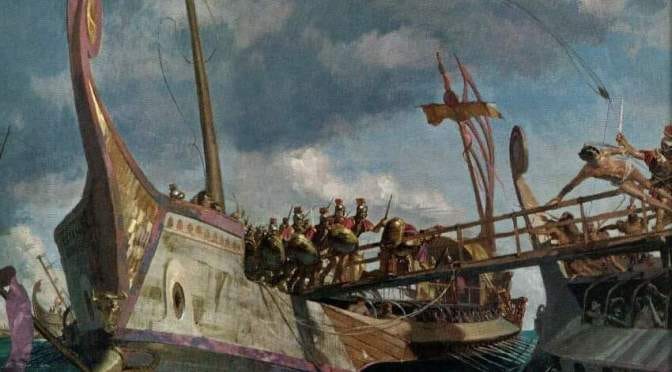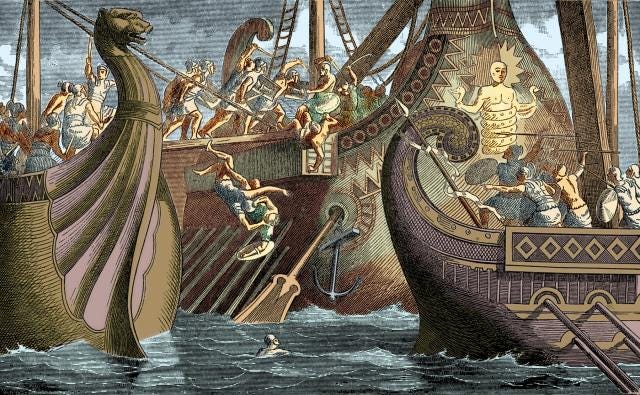Hello Dear Reader,
Today we cover the second and final part of the First Punic War between Rome and Carthage. In our previous publication, we formerly covered the major figures and events leading up to the war, like the Sicilian question. A question never answered but soon to be. So come, dear reader, take a seat around my fire and let’s begin. Roman and Carthaginian ships surge toward each other with great speed, their decks brimming with men of malicious intent. Though for our sailors, in the tense moments before The End of the Beginning, there was little to do but wait. Wait for the inevitable shedding of blood and the chaos of war.
Part 2: A Shared Hatred Burns Hot
Few Resist the Legions
The First Punic War saw a series of intense battles fought across Sicily, North Africa, and the Mediterranean Sea. The first significant factor I should give contextually is that Rome’s growing ability to adapt to naval warfare would prove decisive and would lead to Carthage struggling to maintain control over its territories. Our battles begin below:
1. The Battle of Messana (264 B.C.)
The war's first major engagement took place at Messana, where the Mamertines (a group of Italian mercenaries) had thrown out the Punic garrison and seized control of the city. Threatened by lingering Carthaginian forces, they appealed to Rome for help. Rome would answer the call. Appius Claudius Caudex, the Roman consul, would eventually lead Roman forces to relieve the city after lengthy senate discussion. When he arrived he would defeat the forces of Carthage and Syracuse there.
Rome's intervention at Messana was truly a point of no return as it directly challenged Carthaginian influence in Sicily with a strong military hand. With the Roman legions successfully breaking the Carthaginian forces, the Romans would establish a foothold for Rome in Sicily. This victory would embolden the Romans and would further draw both powers into a protracted struggle for dominance on the island.
2. The Battle of Agrigentum (262 B.C.)
The first large-scale land battle of the war occurred near the city of Agrigentum in 262 B.C. Carthaginian forces under the command of Hanno and Hannibal Gisco occupied the city of Agrigentum, a key stronghold in Sicily. The Roman consuls, Lucius Postumius Megellus and Quintus Mamilius Vitulus, laid siege to Agrigentum, cutting off supplies and waiting for the Carthaginians to surrender.
After several months of siege, a Carthaginian relief force under Hanno arrived, sparking a pitched battle outside the city. However, the Roman legions managed to defeat the Carthaginians in the field, destroying the relief force as well as any hope of Agrigentum being saved from the perils of siege. The only thing that could save them would be surrender and surrender they did. The fall of Agrigentum marked a significant Roman victory as it demonstrated Rome’s ability to win in land engagements and fighting different forces in different ways at once. Even more importantly, it demonstrated Rome’s ability of maintaining control over a hostile island.
3. The Battle of Mylae (260 B.C.)
The Battle of Mylae was the first major naval battle of the war and marked Rome's emergence as a naval power. Up to this point, Carthage’s navy had dominated the seas utterly and completely, but Rome’s determination to challenge Carthaginian supremacy led to the construction of its first major fleet. Commanded by Gaius Duilius, the Roman fleet engaged Carthage’s naval forces off the coast of Mylae, near northern Sicily.
To Rome’s credit (as well as after an embarrassing defeat in the Lipari Islands where they lost 17 ships), they recognized their own lack of naval experience, especially when contrasted to the Carthaginians. This would lead Rome to consider its strengths and think rather outside of the box when it came to combating Carthage on the seas. Though Rome was inexperienced in naval warfare, they recognized they were more experienced in land-based warfare. They wanted to figure out a way to bring land-based combat to the water. Well, they figured out a way alright and introduced an innovative weapon called the corvus, a boarding device that allowed Roman soldiers to fight in hand-to-hand combat on enemy ships.
On a personal note, dear reader, the corvus is perhaps my favorite piece of ancient military technology. The Romans had a land based army. As a result, they did not know how to fight as efficiently at sea as they did on land. So what did the Romans do? They brought the land to them or the closest thing to it. They built great, giant ships with a bridge which attached to Carthaginian vessels so Roman troops could board and use their skills to the fullest extent of their ability. The use of a corvus neutralized the Carthaginian advantage in naval maneuvering and played to Rome’s strength in infantry combat. The battle ended in a decisive Roman victory, with Carthage losing over 50 ships. Mylae was a turning point in the war, as it demonstrated that Rome could compete on the sea and break Carthage’s naval dominance.
4. The Battle of Cape Ecnomus (256 B.C.)
One of the largest naval battles in ancient history, the Battle of Cape Ecnomus, took place in 256 B.C. as Rome attempted to invade North Africa to bring the war to Carthage’s doorstep. Commanded by Marcus Atilius Regulus and Lucius Manlius Vulso, the Roman fleet of over 330 ships set sail from Sicily, intending to land troops in Africa. Carthage, under the command of Hanno and Hamilcar, sent a fleet of similar size to intercept the Romans off the southern coast of Sicily.
The battle was a massive and chaotic engagement, with hundreds of ships and tens of thousands of soldiers involved. Despite being outnumbered and facing the experienced Carthaginian navy, the Romans’ use of the corvus and their well-coordinated, newfound naval tactics allowed them to defeat the Carthaginian fleet. Carthage, for the time, had no answer to the corvus and they paid for it dearly. The Roman victory at Cape Ecnomus would pave the way for the invasion of North Africa, which would bring the war to a new and decisive front.
5. The Battle of Tunis (255 B.C.)
Following the victory at Cape Ecnomus, the Roman consul Marcus Atilius Regulus landed in North Africa and advanced on Tunis, hoping to force Carthage into surrender. Regulus achieved several initial victories, including the capture of Aspis, and pushed deep into Carthaginian territory. However, the Carthaginians, desperate to defend their homeland, regrouped and enlisted the help of a Spartan mercenary commander named Xanthippus, who reformed their military. It is widely known that those who fight for their homeland, in their homeland, fight harder than the invading force.
In the Battle of Tunis, Xanthippus employed superior cavalry and war elephants to devastating effect against the Roman legions. Yes, war elephants and no, the Romans did not have an answer for them. The Roman forces were crushed, and Regulus himself was captured. The defeat at Tunis was a major blow to Rome’s African campaign and marked a turning point in the war, as Carthage regained confidence and shifted its focus back to defending Sicily.
6. The Battle of Drepana (249 B.C.)
The Battle of Drepana was another critical naval engagement that showcased Carthage’s fortitude despite Roman gains. After several victories at sea, Rome sought to blockade the Carthaginian stronghold of Drepana on the western coast of Sicily. The Roman fleet, under Publius Claudius Pulcher, attempted a surprise attack, but the Carthaginian fleet, commanded by Adherbal, was ready.
In the ensuing battle, the Roman fleet was caught off guard, and Pulcher’s forces suffered a catastrophic defeat. Over 90 Roman ships were lost, and many of their sailors drowned. The disaster at Drepana was truly one of Rome’s worst naval defeats and allowed Carthage to maintain control over parts of Sicily for several more years. It also demonstrated that Carthage, though weakened, was still a formidable force, particularly at sea.
7. The Battle of the Aegates Islands (241 B.C.)
The final and decisive engagement of the war occurred at the Aegates Islands in 241 B.C. After years of back-and-forth fighting, both Rome and Carthage were exhausted. Rome, however, had rebuilt its fleet after the losses at Drepana and launched one final naval campaign to end the war. The amount of resources used to complete this rebuilding of its devastated navy was immense. The manpower, materials, and cost was an investment that would certainly be considered a great risk.
This Roman fleet, commanded by Gaius Lutatius Catulus, met the Carthaginian navy near the Aegates Islands, off the western coast of Sicily. It should be noted that said Roman fleet was well-prepared and had trained extensively for this battle, while the Carthaginian fleet, hastily assembled and poorly equipped, was of no match. The Romans secured a decisive victory, sinking or capturing much of the Carthaginian fleet. This defeat effectively ended Carthage’s ability to resupply its forces in Sicily, and they were forced to sue for peace.
The End of the War and Its Aftermath
After over two decades of intense warfare, the First Punic War came to a close in 241 B.C., with Rome emerging as the victor. The war had tested both Rome and Carthage to their limits, depleting their resources and pushing each other, especially Rome, to innovate militarily. However, in the end, Carthage’s inability to sustain the conflict, both at sea and on land, led to its defeat.
The Peace Treaty and Rome’s Gains
Following our decisive Roman victory at the Battle of the Aegates Islands, Carthage found itself in a truly precarious position where continuing the war was no longer viable. Their navy was shattered, their coffers nearly empty, and their ability to defend their remaining footholds in Sicily was utterly compromised. The Carthaginian Senate, recognizing that further resistance would lead to total collapse, initiated peace negotiations.
The Treaty of Lutatius, named after the Roman consul Gaius Lutatius Catulus, was signed in 241 B.C. and marked the official end of the war. The terms of the treaty were highly favorable to Rome and are as follows:
Carthage was forced to evacuate Sicily, surrendering its territorial control of the island. Sicily became Rome’s first overseas province, marking the beginning of Roman expansion outside the Italian peninsula (Whether that comment detailing Sicily outside of Italy will upset some Sicilians or Italians, I will leave up to you).
Carthage was required to pay a substantial war indemnity of 3,200 talents of silver over ten years to compensate Rome for its war expenses. This financial burden weakened Carthage’s economy for years to come and would also leave a lingering bitter taste in their mouths.
Carthage was also restricted in its military movements. It had to disband much of its navy and limit its military presence in the Mediterranean, curbing its influence and future ambitions in the region.
For Rome, this was, by all means, a significant victory. Not only had they broken Carthage’s dominance in the western Mediterranean, but they also gained strategic control of Sicily—a key hub for future trade and military operations. The island became Rome's first province, governed by a Roman magistrate, and would serve as a model for future territorial acquisitions outside the peninsula.
One wonders if Rome has lost this war, would there have been a Roman Empire at all? I will leave that decision up to you.
Carthage’s Internal Struggles
To bring additional details to Carthage, the aftermath of the First Punic War was devastating for them. The loss of Sicily and the burden of the indemnity caused widespread internal unrest within its territories. Soon after the war, Carthage faced a major internal crisis known as the Mercenary War (or Truceless War), where unpaid mercenaries who had fought in the war revolted against their former employers. This brutal conflict lasted from 241 to 237 B.C. and further weakened Carthage's position both domestically and internationally.
Additionally, Carthage had to deal with territorial losses beyond Sicily. Taking advantage of Carthage's weakened state, Rome annexed the islands of Sardinia and Corsica in 238 B.C. Carthage was in no position to resist, and this loss of further territory deepened the humiliation and resentment.
Rome’s Rise as a Mediterranean Power
Rome’s victory in the First Punic War marked a major shift in Mediterranean geopolitics. Before the war, Carthage had been the preeminent maritime power in the western Mediterranean. Now, Rome had asserted itself not only as a land power but as a formidable force at sea. Carthage had simply not expected this. The acquisition of Sicily, and later Sardinia and Corsica, gave Rome valuable resources and strategic bases from which to launch further expansions.
Moreover, and what I would argue to be more important, would be that the First Punic War set a precedent for how Rome would conduct its foreign policy in future conflicts:
Expansion through military conquest: Rome was no longer just defending its borders; it was actively seeking new territories to control and govern. The Romans had had a taste of victory and there was no stopping them now.
Naval development: The war forced Rome to develop a navy from scratch, which would prove invaluable in future conflicts, particularly in the upcoming wars against Carthage. Of course, they did not know there would be additional wars after the First Punic War but it would still prove useful.
Institution of provinces: Sicily became the first of many Roman provinces, each governed by administrative officials who would oversee its integration into the Republic and manage tax collection, legal matters, and defense.
Carthage’s Recovery and the Path to the Second Punic War
Despite the crushing defeat, Carthage was not finished. The city’s recovery, particularly under the leadership of the Barcid family, set the stage for future conflict with Rome. Hamilcar Barca, a brilliant Carthaginian general, emerged as a key figure in Carthage’s resurgence. Following the end of the Mercenary War, Hamilcar led Carthaginian efforts to expand into Hispania (modern-day Spain), where Carthage sought new resources and military strength.
Hamilcar’s efforts in Hispania allowed Carthage to rebuild its economy and military, laying the groundwork for a renewed struggle with Rome. His son, Hannibal Barca, would carry the torch of Carthage’s ambition, leading to the Second Punic War.
Well, dear reader, the treaty is signed and the shared hatred between Rome and Carthage burns even hotter than before. Although for now there would be peace for now, many more lives would be lost before this rivalry would end. In our next edition, we will begin the first part of the Second Punic War—a conflict that would see Rome face one of its greatest military challenges yet, in the form of Hannibal’s daring invasion of Italy.
Yours Truly,
-Flint

